Section Review 82 Photosynthesis an Overview Answer Key
Photosynthesis
41 Overview of Photosynthesis
Learning Objectives
By the end of this section, you lot volition exist able to do the following:
- Explain the significance of photosynthesis to other living organisms
- Depict the main structures involved in photosynthesis
- Identify the substrates and products of photosynthesis
Photosynthesis is essential to all life on earth; both plants and animals depend on it. Information technology is the only biological process that tin can capture free energy that originates from sunlight and converts it into chemical compounds (carbohydrates) that every organism uses to power its metabolism. It is likewise a source of oxygen necessary for many living organisms. In brief, the free energy of sunlight is "captured" to energize electrons, whose free energy is then stored in the covalent bonds of saccharide molecules. How long lasting and stable are those covalent bonds? The energy extracted today past the called-for of coal and petroleum products represents sunlight energy captured and stored past photosynthesis 350 to 200 meg years ago during the Carboniferous Period.
Plants, algae, and a group of bacteria called cyanobacteria are the merely organisms capable of performing photosynthesis ((Figure)). Because they use light to manufacture their own food, they are called photoautotrophs (literally, "self-feeders using light"). Other organisms, such every bit animals, fungi, and most other leaner, are termed heterotrophs ("other feeders"), because they must rely on the sugars produced past photosynthetic organisms for their energy needs. A 3rd very interesting group of bacteria synthesize sugars, not by using sunlight's energy, but by extracting free energy from inorganic chemical compounds. For this reason, they are referred to as chemoautotrophs.
Photoautotrophs including (a) plants, (b) algae, and (c) cyanobacteria synthesize their organic compounds via photosynthesis using sunlight as an energy source. Cyanobacteria and planktonic algae can abound over enormous areas in water, at times completely covering the surface. In a (d) deep sea vent, chemoautotrophs, such as these (e) thermophilic bacteria, capture energy from inorganic compounds to produce organic compounds. The ecosystem surrounding the vents has a various array of animals, such as tubeworms, crustaceans, and octopuses that derive energy from the leaner. (credit a: modification of work by Steve Hillebrand, U.Southward. Fish and Wildlife Service; credit b: modification of work by "eutrophication&hypoxia"/Flickr; credit c: modification of piece of work by NASA; credit d: University of Washington, NOAA; credit e: modification of piece of work by Marker Ameliorate, West Declension and Polar Regions Undersea Research Centre, UAF, NOAA)
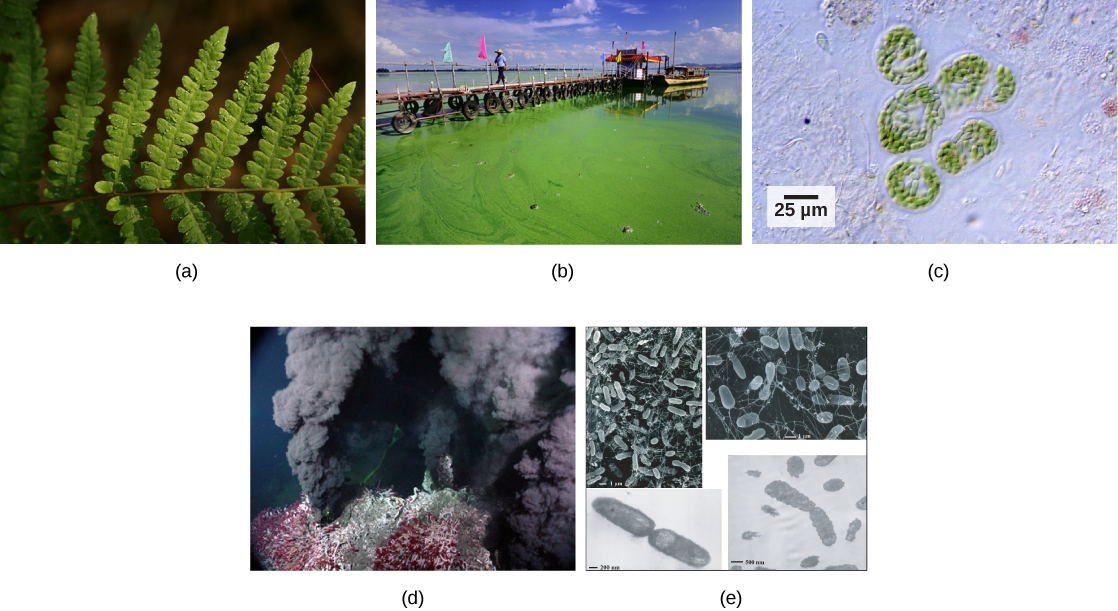
The importance of photosynthesis is not just that information technology can capture sunlight'southward energy. Afterward all, a lizard sunning itself on a cold day can utilise the lord's day's energy to warm up in a process called behavioral thermoregulation. In contrast, photosynthesis is vital because information technology evolved as a way to shop the energy from solar radiation (the "photo-" part) to energy in the carbon-carbon bonds of saccharide molecules (the "-synthesis" part). Those carbohydrates are the energy source that heterotrophs employ to power the synthesis of ATP via respiration. Therefore, photosynthesis powers 99 percent of World'due south ecosystems. When a top predator, such every bit a wolf, preys on a deer ((Figure)), the wolf is at the end of an free energy path that went from nuclear reactions on the surface of the sunday, to visible light, to photosynthesis, to vegetation, to deer, and finally to the wolf.
The energy stored in carbohydrate molecules from photosynthesis passes through the nutrient chain. The predator that eats these deer receives a portion of the free energy that originated in the photosynthetic vegetation that the deer consumed. (credit: modification of work by Steve VanRiper, U.South. Fish and Wildlife Service)
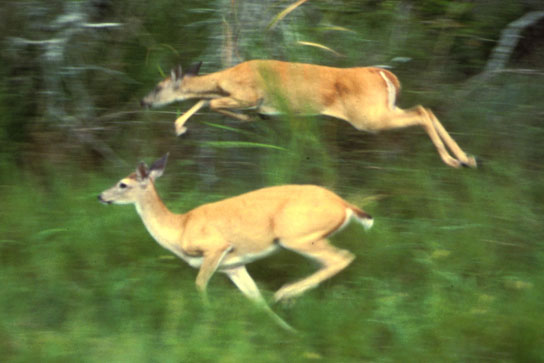
Main Structures and Summary of Photosynthesis
Photosynthesis is a multi-step process that requires specific wavelengths of visible sunlight, carbon dioxide (which is low in energy), and water equally substrates ((Figure)). After the process is complete, it releases oxygen and produces glyceraldehyde-three-phosphate (GA3P), likewise as uncomplicated sugar molecules (loftier in energy) that can then exist converted into glucose, sucrose, or any of dozens of other saccharide molecules. These sugar molecules incorporate energy and the energized carbon that all living things need to survive.
Photosynthesis uses solar energy, carbon dioxide, and water to produce free energy-storing carbohydrates. Oxygen is generated as a waste product product of photosynthesis.

The following is the chemical equation for photosynthesis ((Figure)):
The basic equation for photosynthesis is deceptively simple. In reality, the process takes place in many steps involving intermediate reactants and products. Glucose, the principal energy source in cells, is fabricated from 2 three-carbon GA3Ps.

Although the equation looks simple, the many steps that take place during photosynthesis are really quite complex. Before learning the details of how photoautotrophs plough sunlight into food, it is important to go familiar with the structures involved.
Basic Photosynthetic Structures
In plants, photosynthesis more often than not takes place in leaves, which consist of several layers of cells. The procedure of photosynthesis occurs in a middle layer called the mesophyll. The gas substitution of carbon dioxide and oxygen occurs through small-scale, regulated openings called stomata (singular: stoma), which also play roles in the regulation of gas exchange and water remainder. The stomata are typically located on the underside of the leaf, which helps to minimize water loss due to loftier temperatures on the upper surface of the leafage. Each stoma is flanked by guard cells that regulate the opening and closing of the stomata by swelling or shrinking in response to osmotic changes.
In all autotrophic eukaryotes, photosynthesis takes identify within an organelle called a chloroplast. For plants, chloroplast-containing cells exist more often than not in the mesophyll. Chloroplasts have a double membrane envelope (composed of an outer membrane and an inner membrane), and are ancestrally derived from ancient costless-living cyanobacteria. Within the chloroplast are stacked, disc-shaped structures called thylakoids. Embedded in the thylakoid membrane is chlorophyll, a pigment (molecule that absorbs lite) responsible for the initial interaction between light and plant fabric, and numerous proteins that make up the electron transport chain. The thylakoid membrane encloses an internal space called the thylakoid lumen. As shown in (Figure), a stack of thylakoids is called a granum, and the liquid-filled space surrounding the granum is called stroma or "bed" (not to exist confused with stoma or "mouth," an opening on the leaf epidermis).
Visual Connectedness
Photosynthesis takes identify in chloroplasts, which have an outer membrane and an inner membrane. Stacks of thylakoids called grana class a third membrane layer.
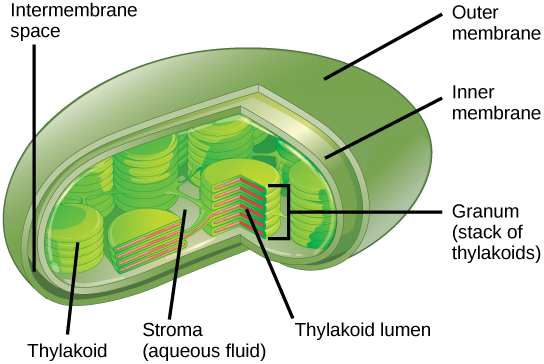
On a hot, dry 24-hour interval, the guard cells of plants close their stomata to conserve h2o. What touch will this have on photosynthesis?
<!–<para> Levels of carbon dioxide (a necessary photosynthetic substrate) volition fall. As a result, the rate of photosynthesis will subtract.–>
The Two Parts of Photosynthesis
Photosynthesis takes place in two sequential stages: the low-cal-dependent reactions and the low-cal-independent reactions. In the low-cal-dependent reactions, energy from sunlight is captivated by chlorophyll and that free energy is converted into stored chemical energy. In the light-independent reactions, the chemical energy harvested during the calorie-free-dependent reactions drives the assembly of saccharide molecules from carbon dioxide. Therefore, although the lite-independent reactions exercise not use light as a reactant, they require the products of the light-dependent reactions to function. In addition, however, several enzymes of the light-independent reactions are activated by light. The light-dependent reactions utilize certain molecules to temporarily shop the energy: These are referred to as free energy carriers. The energy carriers that motion energy from light-dependent reactions to light-independent reactions tin can be idea of as "full" considering they are rich in energy. After the energy is released, the "empty" free energy carriers return to the light-dependent reaction to obtain more than free energy. (Effigy) illustrates the components inside the chloroplast where the light-dependent and calorie-free-independent reactions take place.
Photosynthesis takes identify in 2 stages: calorie-free-dependent reactions and the Calvin cycle. Low-cal-dependent reactions, which have identify in the thylakoid membrane, use light energy to make ATP and NADPH. The Calvin cycle, which takes place in the stroma, uses energy derived from these compounds to make GA3P from CO2.
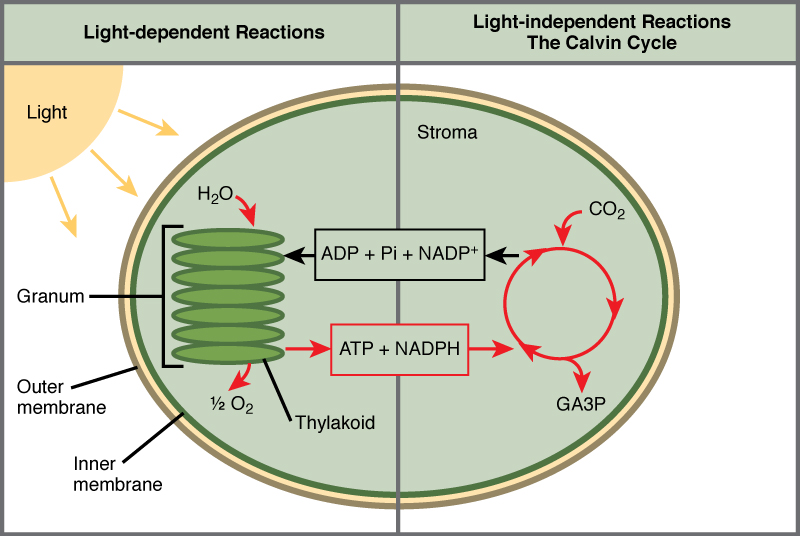
Link to Learning
Click the link to learn more near photosynthesis.
Everyday Connection
Photosynthesis at the Grocery Store
Foods that humans consume originate from photosynthesis. (credit: Associação Brasileira de Supermercados)
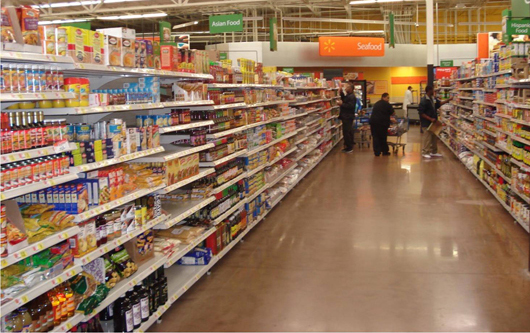
Major grocery stores in the United States are organized into departments, such as dairy, meats, produce, breadstuff, cereals, and and so forth. Each aisle ((Figure)) contains hundreds, if not thousands, of different products for customers to buy and consume.
Although there is a big variety, each detail ultimately tin can be linked dorsum to photosynthesis. Meats and dairy link, considering the animals were fed constitute-based foods. The breads, cereals, and pastas come largely from starchy grains, which are the seeds of photosynthesis-dependent plants. What about desserts and drinks? All of these products contain saccharide—sucrose is a plant product, a disaccharide, a sugar molecule, which is built directly from photosynthesis. Moreover, many items are less plainly derived from plants: For example, paper goods are generally plant products, and many plastics (abundant equally products and packaging) are derived from "algae" (unicellular plant-like organisms, and blue-green alga). Virtually every spice and flavoring in the spice aisle was produced by a plant equally a leaf, root, bark, flower, fruit, or stalk. Ultimately, photosynthesis connects to every meal and every food a person consumes.
Department Summary
The process of photosynthesis transformed life on Earth. Past harnessing energy from the sun, the development of photosynthesis allowed living things access to enormous amounts of free energy. Because of photosynthesis, living things gained admission to sufficient energy that allowed them to build new structures and reach the biodiversity axiomatic today.
Only certain organisms (photoautotrophs), tin perform photosynthesis; they require the presence of chlorophyll, a specialized paint that absorbs sure wavelengths of the visible spectrum and tin can capture free energy from sunlight. Photosynthesis uses carbon dioxide and water to gather carbohydrate molecules and release oxygen equally a byproduct into the temper. Eukaryotic autotrophs, such as plants and algae, have organelles called chloroplasts in which photosynthesis takes place, and starch accumulates. In prokaryotes, such equally cyanobacteria, the process is less localized and occurs within folded membranes, extensions of the plasma membrane, and in the cytoplasm.
Visual Connexion Questions
(Figure) On a hot, dry twenty-four hour period, the guard cells of plants close their stomata to conserve h2o. What bear on will this have on photosynthesis?
(Figure) Levels of carbon dioxide (a necessary photosynthetic substrate) will immediately fall. As a issue, the rate of photosynthesis will be inhibited.
Review Questions
Which of the following components is not used past both plants and cyanobacteria to carry out photosynthesis?
- chloroplasts
- chlorophyll
- carbon dioxide
- water
A
What ii main products result from photosynthesis?
- oxygen and carbon dioxide
- chlorophyll and oxygen
- sugars/carbohydrates and oxygen
- sugars/carbohydrates and carbon dioxide
C
In which compartment of the plant cell practice the low-cal-independent reactions of photosynthesis take identify?
- thylakoid
- stroma
- outer membrane
- mesophyll
B
Which statement almost thylakoids in eukaryotes is not right?
- Thylakoids are assembled into stacks.
- Thylakoids be as a maze of folded membranes.
- The space surrounding thylakoids is called stroma.
- Thylakoids contain chlorophyll.
B
Predict the terminate result if a chloroplast'due south light-independent enzymes adult a mutation that prevented them from activating in response to low-cal.
- GA3P aggregating
- ATP and NADPH accumulation
- H2o aggregating
- Carbon dioxide depletion
B
How are the NADPH and GA3P molecules made during photosynthesis similar?
- They are both end products of photosynthesis.
- They are both substrates for photosynthesis.
- They are both produced from carbon dioxide.
- They both store energy in chemical bonds.
D
Disquisitional Thinking Questions
What is the overall effect of the calorie-free reactions in photosynthesis?
The outcome of light reactions in photosynthesis is the conversion of solar energy into chemical free energy that the chloroplasts tin use to do work (by and large anabolic production of carbohydrates from carbon dioxide).
Why are carnivores, such as lions, dependent on photosynthesis to survive?
Because lions eat animals that eat plants.
Why are energy carriers thought of equally either "full" or "empty"?
The free energy carriers that move from the light-dependent reaction to the calorie-free-independent one are "full" because they bring free energy. After the energy is released, the "empty" free energy carriers return to the light-dependent reaction to obtain more free energy. There is not much actual move involved. Both ATP and NADPH are produced in the stroma where they are as well used and reconverted into ADP, Pi, and NADP+.
Describe how the grey wolf population would be impacted by a volcanic eruption that spewed a dense ash cloud that blocked sunlight in a section of Yellowstone National Park.
The gray wolves are apex predators in their food spider web, meaning they swallow smaller prey animals and are not the prey of whatsoever other animal. Blocking sunlight would prevent the plants at the bottom of the nutrient web from performing photosynthesis. This would kill many of the plants, reducing the food sources available to smaller animals in Yellowstone. A smaller prey animal population ways that fewer wolves can survive in the area, and the population of grey wolves will subtract.
How does the closing of the stomata limit photosynthesis?
The stomata regulate the commutation of gases and water vapor between a foliage and its surrounding surround. When the stomata are closed, the water molecules cannot escape the foliage, but the leaf also cannot acquire new carbon dioxide molecules from the surroundings. This limits the lite-independent reactions to only continuing until the carbon dioxide stores in the leaf are depleted.
Glossary
- chemoautotroph
- organism that can build organic molecules using energy derived from inorganic chemicals instead of sunlight
- chloroplast
- organelle in which photosynthesis takes place
- granum
- stack of thylakoids located inside a chloroplast
- heterotroph
- organism that consumes organic substances or other organisms for nutrient
- light-dependent reaction
- first stage of photosynthesis where certain wavelengths of the visible calorie-free are absorbed to form two energy-conveying molecules (ATP and NADPH)
- light-independent reaction
- 2d stage of photosynthesis, through which carbon dioxide is used to build sugar molecules using energy from ATP and NADPH
- mesophyll
- middle layer of chlorophyll-rich cells in a leafage
- photoautotroph
- organism capable of producing its ain organic compounds from sunlight
- pigment
- molecule that is capable of arresting certain wavelengths of lite and reflecting others (which accounts for its color)
- stoma
- opening that regulates gas exchange and water evaporation between leaves and the environment, typically situated on the underside of leaves
- stroma
- fluid-filled space surrounding the grana within a chloroplast where the light-independent reactions of photosynthesis take identify
- thylakoid
- disc-shaped, membrane-bound structure within a chloroplast where the calorie-free-dependent reactions of photosynthesis have identify; stacks of thylakoids are called grana
- thylakoid lumen
- aqueous infinite bound by a thylakoid membrane where protons accumulate during light-driven electron transport
Source: https://opentextbc.ca/biology2eopenstax/chapter/overview-of-photosynthesis/
0 Response to "Section Review 82 Photosynthesis an Overview Answer Key"
Post a Comment